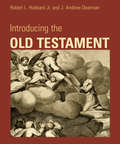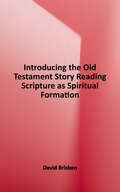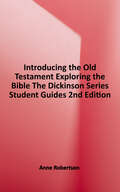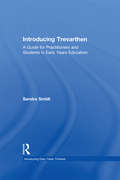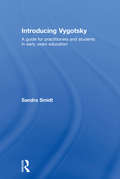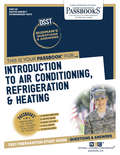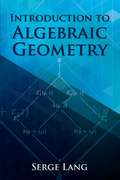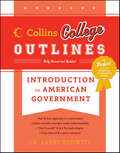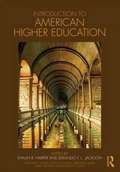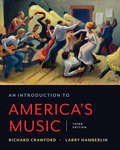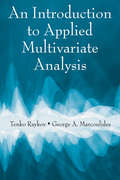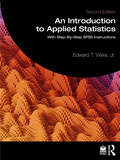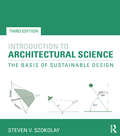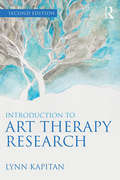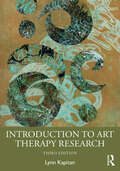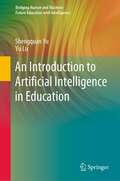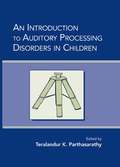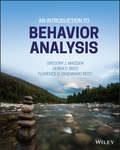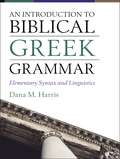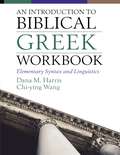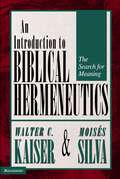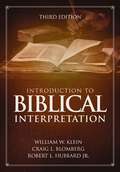- Table View
- List View
Introducing the Old Testament
by Robert L. Hubbard Jr. J. Andrew DearmanThe newest and best Old Testament intro for university and seminary studentsIn this up-to-date, student-friendly text, Robert Hubbard and J. Andrew Dearman bring decades of scholarly study and classroom experience to bear as they introduce readers to the context, composition, and message of the Old Testament.Each chapter orients readers to the Old Testament book or books under consideration, outlining historical and cultural background, literary features, main characters, and structure. Throughout these discussions—of the Torah, the historical books, the prophets, and the poetry—Hubbard and Dearman also identify and trace key theological themes.Replete with maps, illustrations, sidebars, discussion questions, and suggestions for further reading, Introducing the Old Testament will equip students to read, wrestle with, and personally engage these ancient sacred texts.
Introducing the Old Testament: A Short Guide to Its History and Message
by Tremper Longman IIIAn abridged edition of the bestselling book An Introduction to the Old Testament, this rich guide makes Old Testament scholarship accessible to the average reader. Renowned Bible scholar Tremper Longman III gathers the best in historical research and literary analysis to lead the reader through each book of the Old Testament. Most significantly, Longman explores the meaning of each book in light of its cultural setting. Abbreviated chapters highlight key research discoveries, ensuring that the information is both significant and manageable. Including questions at the end of each chapter for group discussion or personal reflection, Introducing the Old Testament makes the words, history, and culture of biblical times come alive for readers. Laypersons as well as church leaders will take away a solid understanding of the historical background and theological message of the Old Testament and be inspired to apply biblical truths to their lives.
Introducing the Old Testament Story: Reading Scripture as Spiritual Formation, 1st Edition
by David BrisbenThis book familiarizes students with the Ancient Near Eastern writings that compose the Old Testament. Through the application of literary, historical, and cultural analysis, this textbook helps the modern reader understand the story of the ancient Hebrews and their relationship to God and experience it as the ancient Hebrews did, encouraging a deeply personal and divine connection with the material. The text begins by providing background information regarding the Old Testament. The first two chapters provide context as to what the Old Testament is, where and when its story occurred, a general idea of what the story is about, how the story progressed over time, how to approach scholarly study of the writings, and the authenticity of the works. Each succeeding chapter addresses specific writings within the Old Testament, bringing to light the literary devices at play, the cultural context and significance of each piece, and how ancient Hebrews would have consumed and reacted to each selection. Written to inspire engagement with Old Testament writings on both an academic and spiritual level, Introducing the Old Testament Story is ideal for introductory or survey courses on the Old Testament, as well as courses on religion, especially those focusing on the place of the Bible in spiritual formation. David Brisben, Ph.D., is a professor of Christian ministries at John Brown University. He earned his master's in divinity degree from Erskine Seminary and his doctorate degree from Trinity Evangelical Divinity School. His passion for storytelling, and more specifically the stories found in the Old and New Testaments, drives his vocational calling to teach students what it means to enter and live in God's story.
Introducing the Old Testament - Student Text - Second Edition: Exploring the Bible: The Dickinson Series
by Anne RobertsonBefore Stonehenge or the wheel, back before the pyramids, math, or even the crudest writing existed, ancient peoples gathered and told stories. They told stories of how the world began, what the first people were like, and which of them were heroes or failures. They tried to make sense of the world around them and tried to sort out who the gods were and what those gods wanted from them. More than ten thousand years later, one set of those stories has come down to us in the form of the Old Testament. It is the story of the Jewish people and their distinctive God, giving us a glimpse through story, song, history, and law of the rocky, raucous, faithful, fumbling beginnings of one of the oldest religions on earth. Perhaps you think you know it. Think again. This second course in Exploring the Bible: The Dickinson Series will help you better understand the Old Testament in the context of the world in which it was written. Use it as designed in small-group study or work with it on your own. Either way, you will come to a new appreciation for this amazing collection of ancient texts and the faith that they represent. A detailed Leader's Guide for this study is sold separately. Other volumes in the series include: Volume 1: What Is the Bible? Volume 3: Introducing the New Testament
Introducing Trevarthen: A Guide for Practitioners and Students in Early Years Education (Introducing Early Years Thinkers)
by Sandra SmidtColwyn Trevarthen’s seminal work has earned him a place alongside the most prestigious thinkers, writers and researchers into human development. He is universally acknowledged as the pre-eminent expert on foetal, neonatal and early childhood development. Sandra Smidt examines the impact of his scientific training, linked to his interest in how filmed episodes of mother or father/baby interactions might inform his understanding about early sociocultural development, encouraging us to view the human infant with fresh eyes and realise how purposive human behaviour is from the start. His interest in and collaborations with others introduce the reader to the idea of communicative musicality which, together with physical movement, lead the child to acquiring language. This book focuses on the earliest years of life and makes complex ideas accessible and applicable to a range of settings. As well as providing a glossary of key terms and an introduction to the life and work of Trevarthen, the book is split into three parts: From foetus to neonate, The remainder of the first year of life and From one to three. Each part offers case studies, practical examples, draws on recent research evidence and includes helpful pointers for students, labelled ‘Think about this’. This essential guide to his work will be of interest to professionals working with children in early childhood settings and to undergraduate students training to become early childhood professionals.
Introducing Vygotsky: A Guide for Practitioners and Students in Early Years Education (Introducing Early Years Thinkers)
by Sandra SmidtSandra Smidt takes the reader on a journey through the key concepts of Lev Vygotsky, one of the twentieth century’s most influential theorists in the field of early education. His ground-breaking principles of early learning and teaching are unpicked here using every-day language, and critical links between his fascinating ideas are revealed. Introducing Vygotsky is an invaluable companion for anyone involved with children in the early years. The introduction of Vygotsky’s key concepts is followed by discussion of the implications of these for teaching and learning. Each chapter also includes a useful glossary of terms. This accessible text is illustrated throughout with examples drawn from real-life early years settings and the concepts discussed include: mediation and memory culture and cultural tools mental functions language, concepts and thinking activity theory play and meaning. Essential reading for all those interested in or working with children, Introducing Vygotsky emphasises the social nature of learning and examines the importance of issues such as culture, history, language, and symbols in learning.
Introducing World Religions
by Victoria Kennick UrubshurowIntroducing World Religions offers an exciting new approach to the study of world religions. It explores the main religions of both East and West, situating them in a cross-cultural context and using a powerful dramatic metaphor to bring them alive for students. Ideal for one-semester or modular introductory survey courses, Introducing World Religions will be essential reading for any student of religions, worldwide.
Introducing Writing Across the Curriculum into China
by Dan WuDr. Wu Dan's Introducing Writing Across the Curriculum into China is an important and provocative research study that is broadly international in scope. Of particular significance for education in China, this book provides a historical analysis of writing instruction in China and an original application of activity theory used to analyze problems and possibilities for Writing Across the Curriculum (WAC) in higher education. Through an examination of important aspects of WAC as it has developed in the United States, Dr. Wu Dan brings together various perspectives in support of developing and sustaining WAC programs in China and by analogy throughout the world. Her work opens new avenues for research in writing and for the teaching of courses throughout the curriculum using a writing-in-the-disciplines approach. A major contribution to international WAC scholarship, Introducing Writing Across the Curriculum into China will be invaluable to English faculty and to all readers interested in educational innovations in China.
INTRODUCTION TO AIR CONDITIONING, REFRIGERATION & HEATING: Passbooks Study Guide (DANTES Subject Standardized Tests (DSST))
by National Learning CorporationThe DSST Subject Standardized Tests are comprehensive college and graduate level examinations given by the Armed Forces, colleges and graduate schools. These exams enable students to earn college credit for what they have learned through self-study, on the job, or by other non-traditional means. The DSST Introduction to Air Conditioning, Refrigeration and Heating Passbook® prepares candidates for the DSST exam, which enables schools to award credit for knowledge acquired outside the normal classroom environment. It provides a series of informational texts as well as hundreds of questions and answers in the areas that will likely be covered on your upcoming exam.
Introduction to Algebraic Geometry: Interscience Tracts In Pure And Applied Mathematics, No. 5 (Dover Books on Mathematics)
by Serge LangAuthor Serge Lang defines algebraic geometry as the study of systems of algebraic equations in several variables and of the structure that one can give to the solutions of such equations. The study can be carried out in four ways: analytical, topological, algebraico-geometric, and arithmetic. This volume offers a rapid, concise, and self-contained introductory approach to the algebraic aspects of the third method, the algebraico-geometric. The treatment assumes only familiarity with elementary algebra up to the level of Galois theory.Starting with an opening chapter on the general theory of places, the author advances to examinations of algebraic varieties, the absolute theory of varieties, and products, projections, and correspondences. Subsequent chapters explore normal varieties, divisors and linear systems, differential forms, the theory of simple points, and algebraic groups, concluding with a focus on the Riemann-Roch theorem. All the theorems of a general nature related to the foundations of the theory of algebraic groups are featured.
Introduction to American Government (Collins College Outlines)
by Larry ElowitzMaster Your Coursework with Collins College OutlinesThe Collins College Outline for Introduion to American Government covers all the major events in the creation of both the government and legislation, from the origins of the United States and the Bill of Rights and the Constitution to the three branches of government to civil rights and modern-day public policy. This detailed outline is a must-have for any student of the American political system. Completely revised and updated by Dr. Larry Elowitz, Introduion to American Government includes a test yourself seion with answers and complete explanations at the end of each chapter. Also included are bibliographies for further reading, as well as numerous charts, timelines, and illustrations.The Collins College Outlines are a completely revised, in-depth series of study guides for all areas of study, including the Humanities, Social Sciences, Mathematics, Science, Language, History, and Business. Featuring the most up-to-date information, each book is written by a seasoned professor in the field and focuses on a simplified and general overview of the subje for college students and, where appropriate, Advanced Placement students. Each Collins College Outline is fully integrated with the major curriculum for its subje and is a perfe supplement for any standard textbook.
Introduction to American Higher Education
by Shaun R. Harper; Jerlando F.L JacksonnFaculty; Teaching, Learning and Curriculum; College Students; Organisations, Leadership and Governance; Higher Education Policy.
An Introduction to America's Music (Third Edition)
by Richard Crawford Larry HamberlinAn ear-opening exploration of music's New World, from Puritan psalmody to Hamilton Authors Richard Crawford and Larry Hamberlin use 90 pieces to show how the lively interactions among the folk, popular, and classical spheres have made American music resonate with audiences around the world. Along the way, students gain a clearer understanding of music's role in the history of American society, business, and technology. This purchase offers access to the digital ebook only.
An Introduction to Applied Multivariate Analysis
by Tenko Raykov George A. MarcoulidesThis comprehensive text introduces readers to the most commonly used multivariate techniques at an introductory, non-technical level. By focusing on the fundamentals, readers are better prepared for more advanced applied pursuits, particularly on topics that are most critical to the behavioral, social, and educational sciences. Analogies betwe
An Introduction to Applied Statistics: With Step-By-Step SPSS Instructions
by Edward T. Vieira, Jr.An Introduction to Applied Statistics offers a comprehensive and accessible foundation in applied statistics, empowering students with the essential concepts and practical skills necessary for data-driven decision-making in today's world. Thoroughly covering key topics – including data management, probability fundamentals, data screening, descriptive statistics, and a broad spectrum of inferential analysis techniques – this indispensable guide demystifies statistical concepts and equips students to confidently apply statistical analysis in real-world contexts.With a systematic, beginner-friendly approach, the author assumes no prior knowledge, making complex statistical foundations accessible to students from a variety of disciplines. Concise, digestible chapters build statistical competencies within a practical, evidence-based framework, minimizing technical jargon to facilitate comprehension. Now in its latest edition, the book is fully updated with SPSS v29.0 instructions and screenshots, ensuring compatibility with the most recent software developments. It also includes expanded content on addressing nonrandom sampling issues, such as case weighting, and delves into advanced topics like factor analysis, logistic regression, cluster analysis, and discriminant analysis, catering to the evolving needs of students and professionals alike.An invaluable resource for introductory quantitative research methods courses in psychology, social sciences, business, and marketing, this text combines practical examples, online resources, and an approachable format to support both learning and application.Key Features: Concise chapters integrating real-world applications: Seamlessly blends statistical skills with practical scenarios, illustrating the flexible use of statistics in evidence-based decision-making. Accessible presentation: Offers practical explanations of statistical procedures with minimal technical jargon, enhancing understanding and retention. Foundational preparation: Early chapters are designed to equip students for advanced statistical procedures, building a strong foundational knowledge. Step-by-step SPSS instructions: Provides detailed SPSS v29.0 guidance with screenshots to reinforce comprehension and hands-on skills. Real-world exercises with answers: Includes practical exercises complete with solutions to facilitate active learning and application. Comprehensive instructor resources: Offers extensive teaching support with chapter PowerPoints and test banks to enhance the educational experience.
Introduction to Architectural Science: The Basis of Sustainable Design
by Steven V. SzokolayNow in its third edition, this book provides the ideal and only reference to the physical basis of architectural design. Fully updated and expanded throughout, the book provides the data required for architects to design buildings that will maintain the users comfort in a variety of conditions, with minimal reliance on energy intensive methods like air conditioning. This is not a ‘how to’ book but answers the question why. It equips the reader with the tools to realize the full potential of the good intentions of sustainable, bioclimatic design. All sections have been revised and updated for this third edition including all the most relevant developments affecting heat, light and sound controls. The book responds to the need of understanding beyond ‘rules of thumb’.
Introduction to Art Therapy Research
by Lynn KapitanSince the initial publication of Introduction to Art Therapy Research, interest in this field has grown dramatically along with public policy demands for an up-to-date, culturally relevant evidence base on which to practice. This revised and expanded edition pays particular attention to the field’s unique and compelling questions, most current literature, and emerging trends in research, while guiding readers through the basics of qualitative, quantitative, and art-based research design. Written by a prominent figure in the world of art therapy, this pragmatic text is organized into three parts: Part I provides an overview of the basic steps in conceptualizing an art therapy research study, with an emphasis on perspectives that are intrinsic to art therapy. Chapters in Part II cover an inclusive methodological framework from quantitative and outcomes research to qualitative, practitioner-based field research, critical-participatory orientations, phenomenological and narrative approaches, and the growing influence of art-based research in art therapy. Part III offers up-to-date ethical guidelines and valuable tools for understanding and evaluating research reports, as well as practical guidance for publication in scholarly journals based on the author’s long experience as the editor of the field’s leading scholarly publication. Also included are added coverage on cross-cultural research as well as high quality examples from published, peer-reviewed art therapy research studies that illustrate material throughout the text.
Introduction to Art Therapy Research
by Lynn KapitanThoroughly updated with references to newly published research and engaging first-person reflections from art therapist researchers working throughout the world, the third edition of Introduction to Art Therapy Research places art therapy research within a socially complex world of compelling questions and emerging trends, while guiding readers through basic research design. First published in 2010, this seminal textbook fulfills the need for a pragmatic, educational text that broadly surveys the purpose and role of art therapy research, guides students and practitioners in becoming knowledgeable of their field’s research literature and ethical principles, and instructs them into the kinds of projects, questions, and methods they might undertake. Written by a prominent figure in the world of art therapy, this pragmatic text is organized into three parts: Part I provides an overview of the basic steps in conceptualizing an art therapy research study, with an emphasis on perspectives that are intrinsic to art therapy. Chapters in Part II cover an inclusive methodological framework from quantitative and outcomes research to qualitative, practitioner-based field research, critical-participatory orientations, phenomenological and narrative approaches, and the growing influence of art-based research in art therapy. Part III offers up-to-date ethical guidelines and valuable tools for understanding and evaluating research reports, as well as practical guidance for publication in scholarly journals based on the author’s long experience as the editor of the field’s leading scholarly publication. Also included are added coverage on cross-cultural research as well as high quality examples from published, peer-reviewed art therapy research studies that illustrate material throughout the text.This landmark text will continue to educate and inform new and emerging art therapists.
An Introduction to Artificial Intelligence in Education (Bridging Human and Machine: Future Education with Intelligence)
by Shengquan Yu Yu LuThis book systematically reviews a broad range of cases in education that utilize cutting-edge AI technologies. Furthermore, it introduces readers to the latest findings on the scope of AI in education, so as to inspire researchers from non-technological fields (e.g. education, psychology and neuroscience) to solve education problems using the latest AI techniques. It also showcases a number of established AI systems and products that have been employed for education. Lastly, the book discusses how AI can offer an enabling technology for critical aspects of education, typically including the learner, content, strategy, tools and environment, and what breakthroughs and advances the future holds.The book provides an essential resource for researchers, students and industrial practitioners interested and engaged in the fields of AI and education. It also offers a convenient handbook for non-professional readers who need a primer on AI in education, and who want to gain a deeper understanding of emerging trends in this domain.
An Introduction to Auditory Processing Disorders in Children
by Teralandur K. ParthasarathyAuditory processing in children (APD) comprises an increasingly important clinical area within the broad field of communication disorders. This new textbook presents the major advances in the assessment and management of APD. The chapter authors, highly regarded clinicians and researchers from diverse professional groups, contribute an impressive breadth of knowledge to explain and demystify APD. This text will be useful to students of speech language pathology and audiology, as well as professionals in those fields.
An Introduction to Behavior Analysis
by Derek D. Reed Florence D. DiGennaro Reed Gregory J. MaddenExplore a fascinating introductory treatment of the principles of behavior analysis written by three leading voices in the field An Introduction to Behavior Analysis delivers an engaging and comprehensive introduction to the concepts and applications of behavior analysis for students of behavior analysis. Written from the ground up to capture and hold student interest, the book keeps its focus on practical issues. This book offers readers sound analyses of Pavlovian and operant learning, reinforcement and punishment, motivation and stimulus control, language and rule-following, decision-making and clinical behvior analysis. With fully up to date empirical research references and theoretical content, An Introduction to Behavior Analysis thoroughly justifies every principle it describes with empirical support and explicitly points out where more data are required. The text encourages students to analyze their own experiences and some foundational findings in the field in a way that minimizes jargon and maximizes engagement. Readers will also benefit from the inclusion of: A clear articulation and defense of the philosophical assumptions and overarching goals of behavior analysis. A thorough description of objective data collection, experimental methods, and data analysis in the context of psychology An exploration of the core principles of behavior analysis, presented at a level comprehensible to an introductory audience A broad array of principles that cover issues as varied as language, substance-use disorders, and common psychological disorders Perfect for students taking their first course in behavior analysis or behavior modification, An Introduction to Behavior Analysis will also earn a place in the libraries of students pursuing certification through the Behavior Analysis Certification Board or taking courses in the applied psychological sciences.
An Introduction to Biblical Greek Grammar: Elementary Syntax and Linguistics
by Dana M. HarrisAn Introduction to Biblical Greek Grammar focuses on the linguistic and syntactic elements of Koine Greek to equip learners for accurate interpretation. Drawing upon twenty years of Greek teaching experience and the latest developments in linguistics and syntax, Harris introduces students to basic linguistic concepts and categories necessary for grasping Greek in ways that are clear and intuitive. This solid foundation enables students first to internalize key concepts, then to apply and build upon them as more complex ideas are introduced.Several features are specifically designed to aid student's learning:Key concepts are graphically coded to offer visual reinforcement of explanations and to facilitate learning forms and identifying their functionsKey concepts are followed by numerous examples from the Greek New TestamentStudents learn how to mark Greek texts so that they can begin to "see" the syntax, identify the boundaries of syntactic units, and construct syntactic outlines as part of their preaching or teaching preparationFour integrative chapters, roughly corresponding to the midterms and final exams of a two-semester sequence, summarize material to date and reinforce key concepts. Here students are also introduced to exegetical and interpretive concepts and practices that they will need for subsequent Greek studies and beyond."Going Deeper" and "For the Curious" offer supplemental information for students interested in learning more or in moving to advanced language study.The accompanying workbook and video lectures (both sold separately) reinforce key concepts through additional contact with the material from each chapter of the grammar. All exercises in the workbook are taken from the Greek New Testament and the Septuagint and include extensive syntactical and exegetical notes to aid students.
An Introduction to Biblical Greek Workbook: Elementary Syntax and Linguistics
by Dana M. Harris Chi-ying WongThis workbook is designed to accompany An Introduction to Biblical Greek Grammar, which focuses on the linguistic and syntactic elements of Koine Greek to equip learners for accurate interpretation. It reinforces key concepts student learn through parsing and translation exercises for each chapter. All texts are taken from the Greek New Testament and the Septuagint and include extensive syntactical and exegetical notes to aid students.In An Introduction to Biblical Greek Grammar, author Dana Harris draws upon twenty years of Greek teaching experience and the latest developments in linguistics and syntax to introduce students to basic linguistic concepts and categories necessary for grasping Greek in ways that are clear and intuitive. This solid foundation enables students first to internalize key concepts, then to apply and build upon them as more complex ideas are introduced.Several features are specifically designed to aid student's learning:Key concepts are graphically coded to offer visual reinforcement of explanations and to facilitate learning forms and identifying their functionsKey concepts are followed by numerous examples from the Greek New TestamentStudents learn how to mark Greek texts so that they can begin to "see" the syntax, identify the boundaries of syntactic units, and construct syntactic outlines as part of their preaching or teaching preparationFour integrative chapters, roughly corresponding to the midterms and final exams of a two-semester sequence, summarize material to date and reinforce key concepts. Here students are also introduced to exegetical and interpretive concepts and practices that they will need for subsequent Greek studies and beyond."Going Deeper" and "For the Curious" offer supplemental information for students interested in learning more or in moving to advanced language study.
Introduction To Biblical Hermeneutics: The Search for Meaning
by Walter KaiserThis standard hermeneutics text has been updated and expanded, allowing the authors to fine-tune their discussions on fundamental interpretive topics. Four new chapters have been added that address more recent controversial issues. The coauthors hold different viewpoints on many topics addressed, making for vibrant, thought-provoking dialogue on this crucial discipline.
Introduction to Biblical Interpretation: 3rd Edition
by Craig L. Blomberg William W. Klein Robert L. Hubbard, Jr.Introduction to Biblical Interpretation, now in its third edition, is a classic hermeneutics textbook that sets forth concise, logical, and practical guidelines for discovering the truth in God&’s Word.With updates and revisions throughout that keep pace with current scholarship, this book offers students the best and most up-to-date information needed to interpret Scripture.Introduction to Biblical Interpretation:Defines and describes hermeneutics, the science of biblical interpretationSuggests effective methods to understand the meaning of the biblical textSurveys the literary, cultural, social, and historical issues that impact any textEvaluates both traditional and modern approaches to Bible interpretationExamines the reader&’s role as an interpreter of the text and helps identify what the reader brings to the text that could distort its messageTackles the problem of how to apply the Bible in valid and significant ways todayProvides an extensive and revised annotated list of books that readers will find helpful in the practice of biblical interpretationUsed in college and seminary classrooms around the world, this volume is a trusted and valuable tool for students and other readers who desire to understand and apply the Bible.
